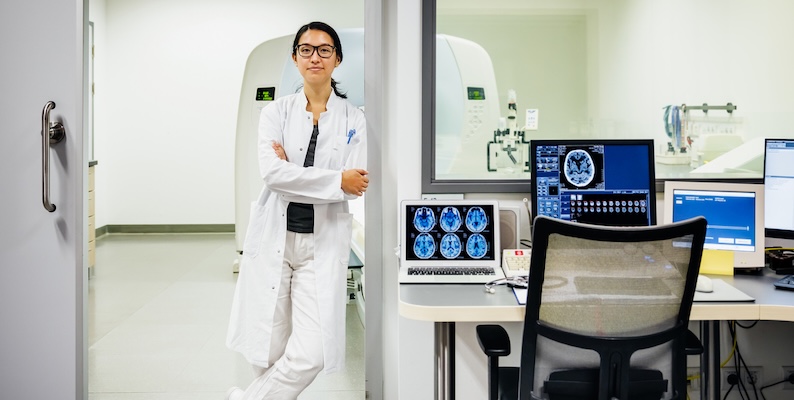Women’s Health Research at Cedars-Sinai

With some of the top research and clinical centers in the U.S., Cedars-Sinai remains at the forefront of innovation in Women’s Health. Our world-class faculty is focused on discovering new information about women’s diseases and investigating potential treatment options for breast cancer, ovarian cancer, heart disease and maternal-fetal medicine, among others. Read how our research teams are redefining women’s health.
Making Strides with TNBC
Thanks to advancements in research, breast cancer treatment has come a long way. In fact, most forms of breast cancer are highly treatable when caught in the early stages. However, triple negative breast cancer (TNBC) remains one of the most difficult types of breast cancer to treat. TNBC does not generally respond to common treatments and, unlike other breast cancer types, frequently metastasizes to the brain.
That’s where Cedars-Sinai’s research team comes in. We’re developing targeted therapies for TNBC by probing isolated live tumor cells to find the differences we can exploit. Our goal is to discover which drugs can destroy patient-specific cancer cells and which properties of a tumor cell can act as predictors for these life-threatening forms of cancer.
Ultimately, we hope to develop personalized treatment options and enhance the cancer diagnostic tools that can save lives. Though the research team’s work is never done, we’re proud of the advances our faculty has made in TNBC treatment.

Weighing the Risks and Benefits of Hormone Replacement Therapy
While hormone replacement therapy remains a controversial treatment, a new imaging study by investigators at Cedars-Sinai suggests that it may be worth a second look. Our team’s research found that women using hormone replacement therapy to relieve menopause symptoms face a lower risk of death and show lower levels of atherosclerosis compared to women who do not use hormone therapy.
Though it is evident that hormone replacement therapy may prove beneficial for some patients, it is certainly not without drawbacks. Studies have also linked it to higher risk of cancer and stroke, and women and their doctors must weigh many factors when deciding whether this treatment option is right for them.
This study did not answer all our remaining questions, and the Cedars-Sinai team will continue to study potential benefits and risks of hormone replacement therapy.

The Effects of Fertility Treatment
Investigators in the Center for Fertility and Reproductive Medicine and the Department of Pediatrics found that babies born as the result of fertility treatments are twice as likely to be born late preterm, at 34-36 weeks. These babies also have a higher admission rate to the Neonatal Intensive Care Unit and require longer hospital stays than the average infant.
This study provided valuable insights into how infertility, and subsequent fertility treatments, affect pregnancy outcomes. Thanks to research conducted over the past two decades, fertility treatments have significantly improved in their effectiveness. Cedars-Sinai’s research team continues to find new ways to improve the pregnancy and birthing experience for both mother and baby.
Cedars-Sinai is committed to the advancement of treatment for women’s diseases. With new data, discoveries and research, we become more tactical in our approach to tackling these diseases. Learn more about how you can join the Cedars-Sinai team and join in our efforts to be on the forefront of healthcare and treatment.
Explore Career Opportunities on Cedars-Sinai's Research Team
-

-
 Article Jan 22, 2025
Article Jan 22, 2025Our Commitment to Hiring Military Veterans
Cedars-Sinai is committed to building a strong veteran community and hiring military veterans to join our team.
-

-
 Video Apr 22, 2025
Video Apr 22, 2025Words of Inspiration, Part 1
Watch our hospital staff read social comments from real patients. Dedicate yourself to work that truly matters.
-
 Video Apr 22, 2025
Video Apr 22, 2025Words of Inspiration, Part 2
Watch our hospital staff read social comments from real patients. Dedicate yourself to work that truly matters.
-

-
 Article Feb 4, 2025
Article Feb 4, 2025Nursing Careers | Cedars-Sinai
Our nurses have work as an integral part of the Los Angeles community from helping to deliver newborns to celebrating the completion of chemotherapy.
-
 Article Feb 7, 2025
Article Feb 7, 2025Information Technology (IT) Careers | Cedars-Sinai
Our IT professionals support new technologies and contribute to projects that are critical to the patient care and health goals of Cedars-Sinai. Join our team today.
-
 Article Feb 8, 2025
Article Feb 8, 2025Imaging and Radiology Careers
At Cedars-Sinai, you can help advance the science of imaging by taking part in pioneering research.
-
 Article Mar 13, 2025
Article Mar 13, 2025Employee Referrals
Learn about Employee Referrals Cedars-Sinai, one of the largest nonprofit academic medical centers in the U.S., and its commitment to transforming healthcare for the benefit of patients.
-
 FAQ Mar 13, 2025
FAQ Mar 13, 2025Frequently Asked Questions
FAQ - Frequently Asked Questions for our Cedars-Sinai talent community.
-
 Jan 11, 2025
Jan 11, 2025Why Cedars-Sinai
When you join our team, you’ll gain access to our state-of-the-art biomedical research facilities and advanced medical education programs. We are dedicated to helping you further your expertise.
-
 Jan 11, 2025
Jan 11, 2025Cedars-Sinai - Living Here
Whether you love world-class entertainment, dining, shopping and museums or prefer the outdoors and sports, Los Angeles has something for everyone.
-
 Jan 11, 2025
Jan 11, 2025Best Hospital – Awards, Rankings & Recognitions
Tied for #1 in California and Los Angeles. The quality and success of Cedars-Sinai is reflected in its many national awards, recognitions, and designations.
-
 Article Mar 14, 2025
Article Mar 14, 2025Cedars-Sinai Employee Benefits
Discover the comprehensive benefits package Cedars-Sinai offers to support the health and wellbeing of our employees.
-
 Article Mar 14, 2025
Article Mar 14, 2025Commitment to Community Health
Cedars-Sinai is committed to providing care and support to the Los Angeles Metro Area communities. Learn more about our community health programs and initiatives.
-
 Article Mar 14, 2025
Article Mar 14, 2025Events
Cedars-Sinai is a non-profit organization that has been serving the Los Angeles community for over 100 years. Learn more about our mission, locations, and career opportunities.
-

-
 Article Mar 27, 2025
Article Mar 27, 2025Nursing Career Growth at Cedars-Sinai
As a nurse at Cedars-Sinai, you’ll find that we empower our employees to reach the highest levels of personal and professional development.
-
 Article Mar 27, 2025
Article Mar 27, 2025Cedars-Sinai - Specialty
As a 915-bed, full-service clinical, research and teaching facility, Cedars-Sinai offers an unmatched variety of challenging and rewarding nursing career opportunities.
-
 Article Mar 28, 2025
Article Mar 28, 2025Pediatric Intensive Care at Cedars-Sinai
Jobs in our Pediatric Intensive Care Unit
-
 Article Mar 31, 2025
Article Mar 31, 2025Human Resources at Cedars-Sinai
Explore the exciting opportunities in Human Resources at Cedars-Sinai, a leading healthcare organization known for its world-class facilities, cutting-edge research, and commitment to patient-centered care.
-
 Article Mar 31, 2025
Article Mar 31, 2025Cedars-Sinai Earns Sixth Consecutive Magnet® Recognition for Nursing Excellence
Cedars-Sinai has earned its sixth consecutive Magnet designation, the highest honor in nursing, for its commitment to excellence in patient care and nursing education.
-
 Article Mar 31, 2025
Article Mar 31, 2025Why Cedars-Sinai
Cedars-Sinai is a nonprofit academic medical center dedicated to providing the best possible patient care, educating tomorrow's physicians and scientists, and achieving scientific breakthroughs.
-
 Article Mar 31, 2025
Article Mar 31, 2025Diversity and Inclusion at Cedars-Sinai
Cedars-Sinai is committed to creating a dynamic, inclusive environment that fuels innovation and the gold standard of patient care.
-
 Article Apr 9, 2025
Article Apr 9, 2025Best Hospital – Awards, Rankings & Recognitions
Tied for #1 in California and Los Angeles. The quality and success of Cedars-Sinai is reflected in its many national awards, recognitions, and designations.
-
 Article Apr 9, 2025
Article Apr 9, 2025Culture at Cedars-Sinai
Learn about Cedars-Sinai, one of the largest nonprofit academic medical centers in the U.S., and its commitment to transforming healthcare for the benefit of patients.
-
 FAQ Apr 17, 2025
FAQ Apr 17, 2025Learn how to protect yourself from fake job offers.
Cedars‑Sinai is committed to the safety and security of our staff, patients and visitors. Unfortunately, you may encounter scams hoping to take advantage of people seeking jobs at Cedars‑Sinai. Here are some things to watch for so that you don’t become a victim.
-
 Article Apr 17, 2025
Article Apr 17, 2025Cedars-Sinai - Living Here
Whether you love world-class entertainment, dining, shopping and museums or prefer the outdoors and sports, Los Angeles has something for everyone.
-
 FAQ Article Apr 17, 2025
FAQ Article Apr 17, 2025Marina del Rey Hospital Employee Referral Info
Know someone that would make a great addition to Cedars-Sinai Marina del Rey Hospital?
-
 Article Apr 21, 2025
Article Apr 21, 2025Float Pool Nursing
Our nursing float pool supplements staffing throughout the medical center based on need. Nurses who work in the Cedars-Sinai float pool can float between multiple areas.
-
 Article Apr 22, 2025
Article Apr 22, 2025Pathology and Lab at Cedars-Sinai
At Cedars-Sinai, our expert pathologists and clinical scientists deliver the highest-quality patient care, teaching, and research.
-
 Employee Testimonial Apr 22, 2025
Employee Testimonial Apr 22, 2025Women Leading Change | Cedars-Sinai
Meet the distinguished women of Cedars-Sinai leading innovation and strengthening our impact in healthcare.
-
 Article Apr 22, 2025
Article Apr 22, 2025Youth Development at Cedars-Sinai
Cedars-Sinai provides programs and services to make a difference in the lives of thousands of children.
-
 Article Feb 7, 2025
Article Feb 7, 2025Academic & Research Careers
Cedars-Sinai is a hub for biomedical research and a training center for future physicians and other healthcare professionals.
-
 Article Feb 7, 2025
Article Feb 7, 2025Cedars-Sinai Marina del Rey Hospital
Cedars-Sinai Marina del Rey Hospital is a nonprofit community hospital committed to serving the needs of the surrounding coastal and westside communities.
-
 Article Feb 7, 2025
Article Feb 7, 2025Corporate Careers
From Marketing to Finance to Human Resources, they ensure that we remain the gold standard of the medical field, that we use our resources efficiently and that the health system provides the best possible patient care.
-
 Article Mar 11, 2025
Article Mar 11, 2025About Cedars-Sinai
Learn about Cedars-Sinai, one of the largest nonprofit academic medical centers in the U.S., and its commitment to transforming healthcare for the benefit of patients.
-
 Article Mar 11, 2025
Article Mar 11, 2025Cedars-Sinai’s Commitment to Equal Opportunities
Discover Cedars-Sinai, a leading nonprofit academic medical center dedicated to transforming healthcare and providing exceptional patient care.
-
 Article Mar 14, 2025
Article Mar 14, 2025Cedars-Sinai Locations
Learn more about Cedars-Sinai, including our mission, locations, and career opportunities in the Los Angeles area.
-
 Article Mar 17, 2025
Article Mar 17, 2025Pharmacy Careers | Cedars-Sinai
At Cedars-Sinai, pharmacists’ expertise is critical to achieving exceptional patient care for which we are known and trusted. Find pharmacy jobs at Cedars-Sinai.
-
 Article Mar 19, 2025
Article Mar 19, 2025Cedars-Sinai Medical Network
The Cedars-Sinai Medical Network is committed to helping primary care and specialist physicians provide excellent care to all their patients.
-
 FAQ Article Mar 24, 2025
FAQ Article Mar 24, 2025New-Graduate RN Residency Program | Cedars-Sinai
Cedars-Sinai developed the New Graduate RN Residency Program as part of its commitment to the successful transition of new grads into rewarding careers.
-
 Article May 29, 2025
Article May 29, 2025Cancer Research at Cedars-Sinai
Cedars-Sinai Cancer is a rapidly expanding academic cancer enterprise with exceptional opportunities for physician scientists, clinical scholars, and research scientists to join and make a difference.
-
 Article Jul 17, 2025
Article Jul 17, 2025See What It Takes To Thrive as an LVN
As a licensed vocational nurse (LVN) with Cedars-Sinai, you’ll have opportunities to learn, grow and lead as you work directly with patients. Hear why you should choose Cedars-Sinai for your career from one of our LVNs
-
 Article Employee Testimonial Aug 12, 2025
Article Employee Testimonial Aug 12, 2025Meet the Healthcare Heroes at Cedars-Sinai
Cedars-Sinai staff were named Healthcare Heroes for their unmatched resilience, dedication, hard work, passion and skill. read more on what they had to say.
-
 Article Sep 16, 2025
Article Sep 16, 2025Explore Oncology Careers at Guerin Children's
Further Your Career at the Forefront of Care
-
 Article Employee Testimonial Oct 10, 2025
Article Employee Testimonial Oct 10, 2025A Day in the Life of a Technical Manager in Ultrasound
Discover how an ultrasound technologist can make a difference in people's lives, with a firsthand account from Lisa Fernandez, a Technical Manager in Ultrasound at Cedars-Sinai.
-
 Article Employee Testimonial Nov 11, 2025
Article Employee Testimonial Nov 11, 2025A Journey from Service to Healthcare
Susan Williams' journey from military service to healthcare recruitment exemplifies the values Cedars-Sinai holds dear.
-
 Nov 7, 2025
Nov 7, 2025Administrative Fellowship Program
The Future Healthcare Leaders Administrative Fellowship Program is a 24-month experience offering immersive rotations, executive mentorship, and growth opportunities to prepare emerging leaders for impact-driven roles in healthcare administration.
-
 Article Employee Testimonial Dec 11, 2025
Article Employee Testimonial Dec 11, 2025From Clinical Trials to Executive Leadership: Billy Gellepis' 16-Year Journey at Cedars-Sinai
Billy Gellepis' story is a testament to what's possible when curiosity meets opportunity. Read about his 16-year journey at Cedars-Sinai, from a clinical trial coordinator to the Executive Director of Clinical and Research Operations.
Jobs for you
- Lead Revenue Cycle Analyst 11286 Patient Financial Services Los Angeles, California
- Medical Assistant - Internal Medicine - Marina Del Rey 13786 Clinical Operations Marina del Rey, California
- Medical Assistant - OB/GYN 13734 Clinical Operations Beverly Hills, California








































